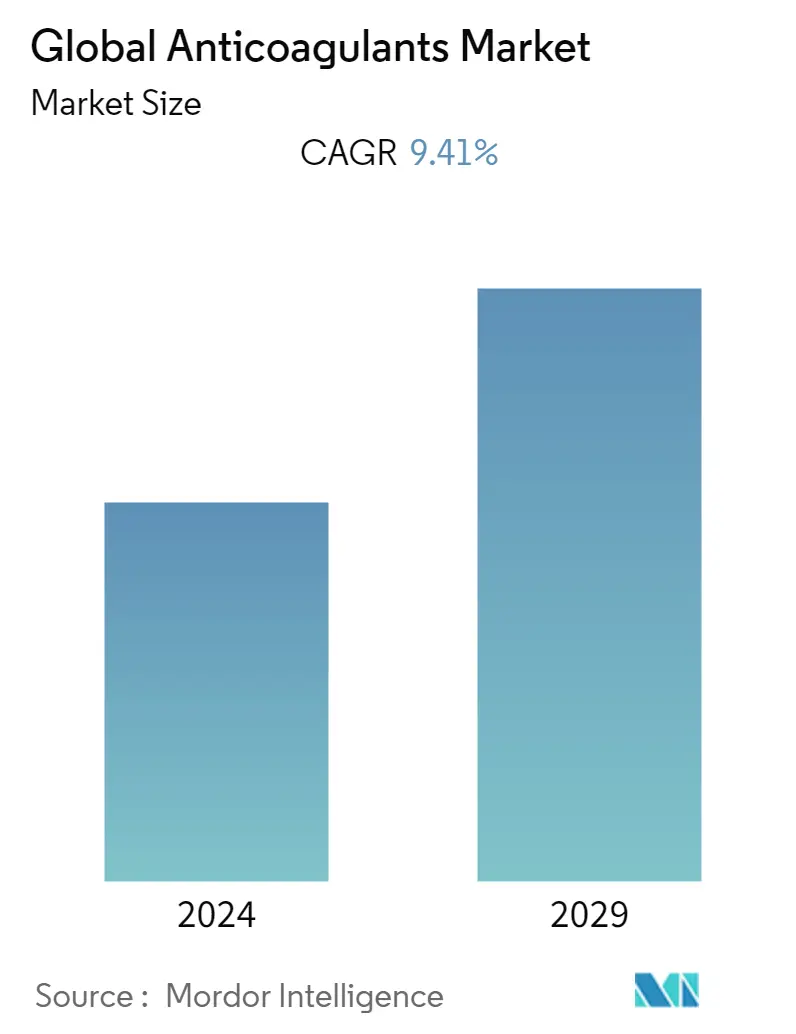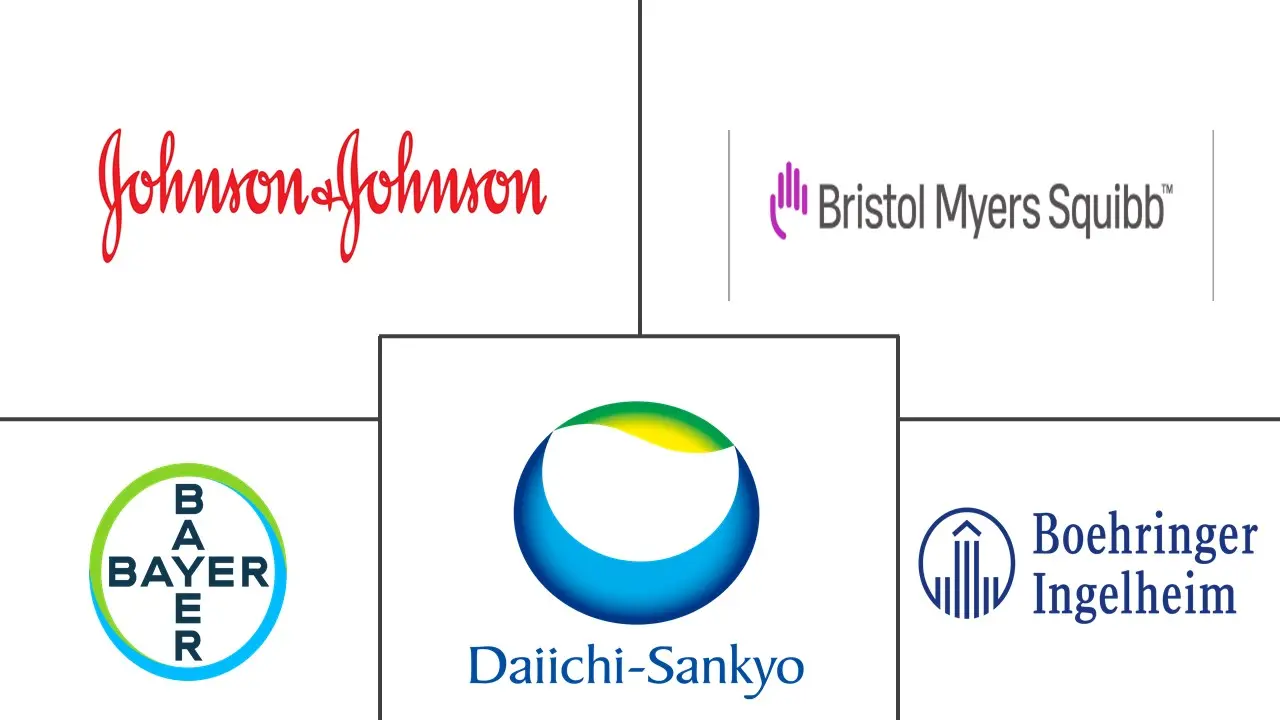Market Size of Global Anticoagulants Industry

| Study Period | 2019 - 2029 |
| Base Year For Estimation | 2023 |
| Forecast Data Period | 2024 - 2029 |
| CAGR | 9.41 % |
| Fastest Growing Market | Asia Pacific |
| Largest Market | North America |
Major Players
*Disclaimer: Major Players sorted in no particular order |
Anticoagulants Market Analysis
The Anticoagulants Market is expected to register a CAGR of 9.41% during the forecast period (2022-2027).
COVID-19 infection is expected to have a substantial impact on the anticoagulant industry due to the quick pace of research. More than ten clinical trials are currently underway to assess the potential of anticoagulants in COVID-19 patients, according to a study published in the American Journal of Cardiovascular Drugs in 2020, and research on parenteral administration strategies for these drugs is being conducted for use in critically ill COVID-19 patients. As a result, the COVID-19 pandemic is expected to have both direct and indirect implications for the market in question. Furthermore, according to World Health Organization Update in January 2021, patients with COVID-19, both confirmed and suspected, should have access to follow-up care with low-dose anticoagulants, according to the World Health Organization. Thus, the demand for anticoagulants increased during COVID-19.
This is attributed to an increase in the incidence of chronic diseases and technological advances in the development of anticoagulant products. Anticoagulants are used to treat and prevent blood clots which can block blood vessels (an artery or a vein) that can lead to serious complications as the clot disrupts the flow of blood to important organs and can result in heart attack and stroke. According to the World Health Organization June 2021, an estimated 17.9 million people die due to cardiovascular diseases worldwide, each year. This represents 35% of global deaths. Additionally, 85% of these cardiovascular disease deaths are due to heart attack and stroke. In addition, according to the article published in Cureus Journal of Medical Science in July 2020, ischemic heart disease (IHD) is a leading cause of death worldwide. Ischemic heart disease affects around 126 million individuals (1,655 per 100,000) globally, which is approximately 1.72% of the world's population. The global prevalence of ischemic heart disease is expected to exceed 1,845 per 100,000 by the year 2030. Furthermore, increasing cases of chronic diseases, unhealthy lifestyles adopted by individuals, and growing adoption of novel oral anticoagulants (NOACs) are the key driving factors in the anticoagulants market.
Moreover, technological advancements in the development of anticoagulant products and approvals are also propelling the growth of the market. For Instance, In June 2021, the United States Food and Drug Administration approved Boehringer Ingelheim's dabigatran etexilate (Pradaxa) anticoagulant oral pellets as the first oral anticoagulant to treat children aged 3 months to less than 12 years old with venous thromboembolism after they have received at least five days of treatment with a blood thinner given by injection.
Thus, all the aforementioned factor is expected to drive the growth of the anticoagulant market over the forecast period. However, stringent regulation and side effects associated with the treatment restrain the market growth over the forecast period.
Anticoagulants Industry Segmentation
As per the scope of the report, anticoagulants are medicines used to treat and prevent blood clots that may occur in blood vessels. The Anticoagulants market is segmented By Drug Class (Novel oral anticoagulants (NOACs), Heparin and Low Molecular Weight Heparin (LMWH), and Vitamin k Antagonist), By Application (Atrial Fibrillation/Myocardial Infarction (Heart Attack), Deep Vein Thrombosis (DVT), Pulmonary Embolism, Other Applications) and Geography (North America, Europe, Asia-Pacific, Middle East and Africa, and South America). The report also covers the estimated market sizes and trends for 17 countries across major regions globally. The report offers the value (in USD million) for the above segments.
| By Drug Class | |
| Novel Oral Anticoagulants (NOACs) | |
| Heparin and Low Molecular Weight Heparin (LMWH) | |
| Vitamin K Antagonist |
| By Application | |
| Atrial Fibrillation/Myocardial Infarction (Heart Attack) | |
| Deep Vein Thrombosis (DVT) | |
| Pulmonary Embolism | |
| Other Applications |
| Geography | ||||||||
| ||||||||
| ||||||||
| ||||||||
| ||||||||
|
Global Anticoagulants Market Size Summary
The anticoagulants market is poised for significant growth, driven by the increasing prevalence of chronic diseases and advancements in technology. Anticoagulants play a crucial role in preventing and treating blood clots, which can lead to severe complications such as heart attacks and strokes. The demand for these medications has been further amplified by the COVID-19 pandemic, as research has explored their potential benefits for infected patients. The market is characterized by the growing adoption of novel oral anticoagulants (NOACs), which offer advantages such as lower bleeding risks and fewer dietary interactions compared to traditional options like warfarin. This shift is particularly notable in developing regions, where NOACs are gaining traction due to their convenience and efficacy.
North America is expected to dominate the global anticoagulants market, supported by a high demand for innovative products and a rising incidence of cardiovascular disorders. The region benefits from a robust healthcare infrastructure and the presence of leading pharmaceutical and biotech companies, which are actively involved in developing new therapeutics. The market is competitive and fragmented, with major players such as Johnson & Johnson, Bayer AG, and Boehringer Ingelheim GmbH driving innovation and product launches. Regulatory approvals, such as those from the FDA for pediatric indications and new formulations, are anticipated to further propel market growth. Despite challenges like stringent regulations and potential side effects, the anticoagulants market is set to expand, fueled by ongoing research and development efforts.
Global Anticoagulants Market Size - Table of Contents
-
1. MARKET DYNAMICS
-
1.1 Market Overview
-
1.2 Market Drivers
-
1.2.1 Increasing Cases of Chronic Diseases
-
1.2.2 Technological Advancements in Development of Anticoagulant Products
-
1.2.3 Growing Adoption of Novel Oral Anticoagulants (NOACs)
-
-
1.3 Market Restraints
-
1.3.1 Stringent Government Regulations
-
1.3.2 Side Effects Associated with Treatment
-
-
1.4 Porter's Five Force Analysis
-
1.4.1 Threat of New Entrants
-
1.4.2 Bargaining Power of Buyers/Consumers
-
1.4.3 Bargaining Power of Suppliers
-
1.4.4 Threat of Substitute Products
-
1.4.5 Intensity of Competitive Rivalry
-
-
-
2. MARKET SEGMENTATION (Market Size by Value - USD million)
-
2.1 By Drug Class
-
2.1.1 Novel Oral Anticoagulants (NOACs)
-
2.1.2 Heparin and Low Molecular Weight Heparin (LMWH)
-
2.1.3 Vitamin K Antagonist
-
-
2.2 By Application
-
2.2.1 Atrial Fibrillation/Myocardial Infarction (Heart Attack)
-
2.2.2 Deep Vein Thrombosis (DVT)
-
2.2.3 Pulmonary Embolism
-
2.2.4 Other Applications
-
-
2.3 Geography
-
2.3.1 North America
-
2.3.1.1 United States
-
2.3.1.2 Canada
-
2.3.1.3 Mexico
-
-
2.3.2 Europe
-
2.3.2.1 Germany
-
2.3.2.2 United Kingdom
-
2.3.2.3 France
-
2.3.2.4 Italy
-
2.3.2.5 Spain
-
2.3.2.6 Rest of Europe
-
-
2.3.3 Asia-Pacific
-
2.3.3.1 China
-
2.3.3.2 Japan
-
2.3.3.3 India
-
2.3.3.4 Australia
-
2.3.3.5 South Korea
-
2.3.3.6 Rest of Asia-Pacific
-
-
2.3.4 Middle-East and Africa
-
2.3.4.1 GCC
-
2.3.4.2 South Africa
-
2.3.4.3 Rest of Middle-East and Africa
-
-
2.3.5 South America
-
2.3.5.1 Brazil
-
2.3.5.2 Argentina
-
2.3.5.3 Rest of South America
-
-
-
Global Anticoagulants Market Size FAQs
What is the current Global Anticoagulants Market size?
The Global Anticoagulants Market is projected to register a CAGR of 9.41% during the forecast period (2024-2029)
Who are the key players in Global Anticoagulants Market?
Johnson & Johnson, Bayer AG, Boehringer Ingelheim GmbH, Bristol-Myers Squibb Company and Daiichi Sankyo Company are the major companies operating in the Global Anticoagulants Market.

